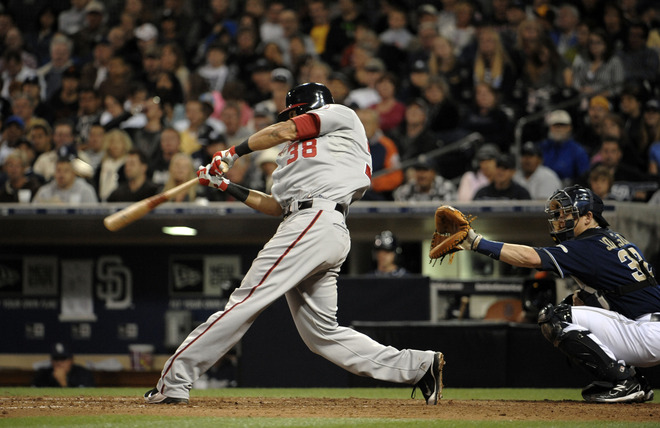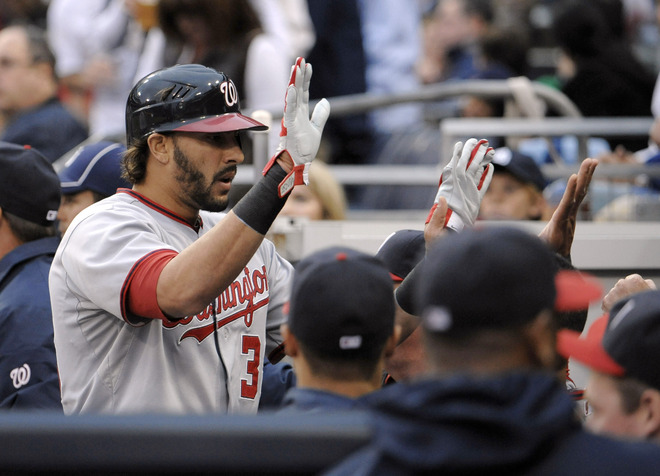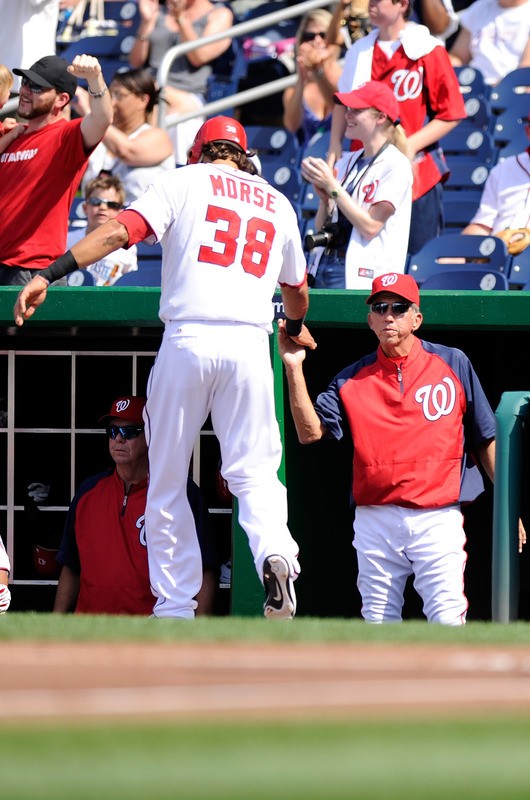 Indians Archive
Indians Archive  Finding the “Right” Fit
Finding the “Right” Fit

As the Indians come out of the All-Star Break, staring firmly at a vital part of their schedule (though that could really be said at any point from here on out), the focus has turned to the Rumor Mill that keeps spinning away on every TV broadcast and every radio sound wave this time of year. By now, you’ve seen all the names of “available” players and the lists of “buyers” and “sellers” as the national analysts ready their “winners” and “losers” of the Trade Deadline piece that come flying out at us every August 1st. With the Indians allegedly being one of the teams picking up the phone to make calls instead of simply fielding calls on players (as has been the case in years past), there is a level of excitement on the North Coast as people sell themselves on Jeff Francoeur or Ryan Ludwick or Josh Willingham as a potential difference-maker down the stretch for the Indians.
However, lost amidst all of this talk that the Indians “need” to add a RH bat for the final two months, preferably of the “impact” variety, is that this “need” for a RH bat is not one that is unique to the second half of this season. Yes, a RH bat would balance out this lineup quite a bit, but what the Indians really need to add is a RH bat that can help this year…and beyond. Perhaps that is why Jeff Francoeur and Ryan Ludwick and Josh Willingham are less than desirable to me in that I get that they would help this year, but then they’re gone and the Indians are left this off-season looking for a RH bat once again.
Obviously everyone knows that Hafner, Sizemore, Choo, and Brantley are all LH, but did anyone notice that the “3B of the Future” who just ascended to the North Coast (and took a pitch off of his face) is also LH? Want to guess what Jason Kipnis is?
Yep, he’s LH and the only two other top-level prospects that figure to offer any real help in the coming years, Nick Weglarz and Zeke Carrera (even as a 4th OF), are both LH as well. So, if the current team stays in place around the diamond and The Chiz and Kipnis take over 3B and 2B on a full-time basis next year, here’s what you’re looking at:
Left-Handed
Hafner
Choo
Sizemore
Brantley
Chisenhall
Kipnis
Switch-Hitter
Santana
Cabrera
Right-Handed
LaPorta
As my friend Tyler recently wrote me, “No wonder they were so hot for LaPorta” in terms of what they targeted in the CC deal. What he means by that (and I’m pretty sure that there was a quote from Shapiro at the time that foretold of this) is that RH bats, particularly power RH bats are a suddenly dying breed in MLB. There are 76 qualified RH hitters in MLB right now, 14 of which have an OPS over .850…and one of them is Jhonny Peralta, who currently has the 8th highest OPS in MLB among RH hitters. In 2007 (just to pick a year in which the Indians were also contending), there were 23 RH hitters with an OPS over .850 when the season ended and the numbers only get bigger the further back you go. Some of this is a function of more stringent PED testing, but 14 RH hitters this year have SLG over .500 as well (and Peralta is 7 on that list) and given that there are 30 teams in MLB, that means about ½ of the teams in MLB have a RH bat that has a SLG over .500 and ½ the teams have a RH bat with an OPS over .850. Interestingly, the Tigers and the White Sox are the only two teams with two RH hitters on either of those lists, but that’s neither here nor there…
Regardless, while the obvious and lazy “they need to make moves NOW to improve this team for the stretch run and a RH bat would be a good start” pieces (without offering much by way of suggestions other than the oft-discussed, overexposed, unattractive options) have flown all around these Interwebs and continue to take up space on people’s front stoops, the starker reality is that the Indians – as an organization – need a RH bat for the second half and for the next couple of years as, if LaPorta happens to flame out, you’re looking at an awfully LH-heavy lineup going forward with the likely replacements for what you would figure to be the July 2012 lineup (Wegz and Zeke) also being LH hitters.
What does that mean for right now?
For starters, it means that the Indians should be targeting RH bats that are under club control for at least a couple of years, that are versatile to play multiple positions as it looks like a majority of positions are “spoken for” or at least reserved for certain players or top prospects, and they should use some level of boldness to perhaps find a potential impact bat that could be available for a team that finds themselves with greater (or different needs) than a RH bat.
 One example of a player like this could be Washington’s Mike Morse, who has emerged this year as a versatile and productive piece after a couple of years of bouncing around in Seattle’s infield and around the diamond for the Nationals. A 29-year-old RH bat, Morse has posted a .306 BA / .351 OBP / .535 SLG / .886 OPS with 15 HR and 17 2B in the 81 games that he’s played this year. He was one of the candidates to be a final All-Star (in that silly vote-in process) and is being paid $1.05M in this, his 1st year of arbitration eligibility, while primarily playing 1B after Adam LaRoche’s injury.
One example of a player like this could be Washington’s Mike Morse, who has emerged this year as a versatile and productive piece after a couple of years of bouncing around in Seattle’s infield and around the diamond for the Nationals. A 29-year-old RH bat, Morse has posted a .306 BA / .351 OBP / .535 SLG / .886 OPS with 15 HR and 17 2B in the 81 games that he’s played this year. He was one of the candidates to be a final All-Star (in that silly vote-in process) and is being paid $1.05M in this, his 1st year of arbitration eligibility, while primarily playing 1B after Adam LaRoche’s injury.
Nice looking player, right…why would the Nationals move such a guy?
Well, the Nats are still on the hook to pay LaRoche $8M next year and have some compelling young players coming up from the Minors (Bryce Harper and Derek Norris) to go along with some players that arrived recently, like Ian Desmond, Danny Espinoza, and Wilson Ramos, not to mention their young arms (Strasburg and Drew Storen) that look to form a nice core of players in the next few years. But would a 29-year-old Morse, under club control through 2013, be a piece that would be most valuable to them as a versatile auxiliary piece for the next two-and-a-half years or as a trading chip that could be used to upgrade their starting pitching or corner OF depth significantly to line all of the pieces up together as we’ve seen so executed so well and so frequently elsewhere in MLB by teams on the rise?
For a team that currently counts Livan Hernandez as their “ace”, one would think that the right package of players could be enough to pry Morse – who is almost a “found” asset by Washington – out of the nation’s capital to improve the long-term standing of the Nats. Interestingly, I happened upon this Q&A with Steven Goldman of B-Pro regarding Morse over at The Nationals Review, with Goldman addressing Morse’s attractiveness as a trade chip thusly:
Charlie (Bethesda, MD): Mike Morse – has he really turned into a 870-ish OPS hitter who can bat against righties? Other than this year’s April slump, he’s been doing this since the beginning of last year. Am I allowed to start believing in this?
Steven Goldman: I very much doubt it lasts, and as much as he’s propping up the lineup right now, I would be looking to see if someone was willing to overpay for that by the deadline.
--snip--
Charlie (Bethesda, MD): Re: Mike Morse – it’s now been 472 PAs of .867 OPS over two seasons. How much longer would he need? Or is it so far out of the realm of possibility because of his age? He’s got a career OPS of .820, and 30% of those PAs came from his .718 age 23 season.
Steven Goldman: Well, I like what he’s done. He’s hit .300/.352/.511 since that season you mention in 608 scattered PAs. He has real value given that he can move around the field and knock the ball. But his 39 walks/140 strikeouts makes me nervous about the inevitable cold streaks or bad BABIP stretch, because players of this model, be they Robinson Cano or Alfonso Soriano, when they go cold, they just contribute nothing. Put that together with his age and that he should be up for arb after the season and I think, “Go fish.”
Maybe it doesn’t “last” for Morse, but as a RH bat that does (now) have a .878 OPS over the last two seasons for the Nats, that’s a player I’d like to see the Indians perhaps “overpay” for, considering that he IS under club control through 2013, even if he’s about to get more expensive through his arbitration seasons. While Goldman is right to see that K/BB rate and raise some red flags, Morse is the type of player that I’d like to see the Indians aggressively go after as a potential long-term solution instead of sifting through the Francoeur/Ludwick/Willingham pile. Though that RH-hitting pile that thrives against LHP has its value for the final 2 months of the season, I’d prefer for the Indians to make a move for a player like Morse.
In case you were wondering where Morse would fit, he played 72 games in RF last year, 27 games in LF this year, and has played 67 games at 1B over the last two years. Between his ability to play both corner OF spots and 1B (plus the availability to be a RH option at DH that isn’t Shelley Duncan), Morse would fit that bill of the versatile RH bat that the Indians should be targeting.
 Though some will point to Casey Blake as the “versatile RH bat” that is likely to show up on the Tribe’s radar, let’s be honest that this current Indians’ team needs Casey Blake…just the Casey Blake of 6 years ago, not the 38-year-old with the .386 SLG (about what Mike Brantley’s SLG) that’s roaming around Chavez Ravine today. The Tribe needs a RH bat that could move around the diamond to fill holes and provide some pop from the right side, and not just for the next two months. Maybe Morse is a guy like that who could fill that role for the next couple of years and, though I’m sensitive to being that guy that says “let’s pick a player off of team X that is allegedly out of the playoff race and figure out how to get him” because the last few Julys were full of conjecture on EVERYONE in a Tribe uniform being traded, the Nationals just may be compelled to use Morse to strengthen some of their organizational weaknesses, namely upper-level starting pitching.
Though some will point to Casey Blake as the “versatile RH bat” that is likely to show up on the Tribe’s radar, let’s be honest that this current Indians’ team needs Casey Blake…just the Casey Blake of 6 years ago, not the 38-year-old with the .386 SLG (about what Mike Brantley’s SLG) that’s roaming around Chavez Ravine today. The Tribe needs a RH bat that could move around the diamond to fill holes and provide some pop from the right side, and not just for the next two months. Maybe Morse is a guy like that who could fill that role for the next couple of years and, though I’m sensitive to being that guy that says “let’s pick a player off of team X that is allegedly out of the playoff race and figure out how to get him” because the last few Julys were full of conjecture on EVERYONE in a Tribe uniform being traded, the Nationals just may be compelled to use Morse to strengthen some of their organizational weaknesses, namely upper-level starting pitching.
Though the Nats would have no interest in The Chiz or the Phelps/Kipnis duo (though I don’t know if I’d want to part with Chisenhall or Kipnis for Morse) because of their own 3B and 2B options, one might think that the Indians could use one of their AAA starters (maybe even Gomez or McAllister if White is anywhere close to returning) and maybe a Nick Weglarz to make this kind of move, perhaps throwing in a lower-level arm to sweeten the pot for the Nationals, a team that is admittedly .500, 11 ½ games out of the NL East race, but “only” 8 games out of the Wild Card race.
However (and stop me if you’ve heard this before), what happens over the next two-and-a-half weeks is going to determine which teams are going to be looking to add pieces and which teams might be looking to move pieces. Whether the Indians are in the former column and the Nats in the latter column remains to be seen, but if the Indians are going to make a move, I’d prefer to see them make one that helps this team past the end of this season. The need for a versatile RH bat is unmistakable, but that need isn’t going to end after the 162nd game of the 2011 season and the Indians should be acting accordingly by targeting players – like Mike Morse – and using their deep prospect pool to acquire a player that can help the team in the short-and-long-term at positions of need.
- NBA Announces 2013-2014 Schedule
- Browns Ink Sharknado
- Sharknado A No-Show For Rookie Camp
- Trent Richardson Out Until Training Camp
- Browns Sign Brandon Jackson
- Carrasco Suspended Eight Games
- Browns Add to Wide Receiver Depth with David Nelson
- Browns Need to Learn from Past Draft Mistakes
- Browns Release Chris Gocong and Usama Young
- Browns Missing on Grimes Disappointing, But Not The End
The TCF Forums
- Chris Grant's first 3 drafts
Kingpin74 (Tuesday, January 21 2014 10:13 AM) - The 2014 Offseason Thread
googleeph2 (Tuesday, January 21 2014 9:36 AM) - 2015 Recruiting
furls (Tuesday, January 21 2014 6:57 AM) - Mike Brown
YahooFanChicago (Monday, January 20 2014 11:15 PM) - Movies coming out
HoodooMan (Monday, January 20 2014 9:34 PM) - 2014 Hoops Hockey Hijinx
jpd1224 (Monday, January 20 2014 4:44 PM) - 2014 Recruiting
jclvd_23 (Monday, January 20 2014 2:26 PM) - Wish List - #4 Pick
Hikohadon (Monday, January 20 2014 1:26 PM) - Official- Browns Coach Search/Rumors
OldDawg (Sunday, January 19 2014 6:48 PM) - #1 overall pick Anthony Bennett
TouchEmAllTime (Sunday, January 19 2014 1:28 PM)


